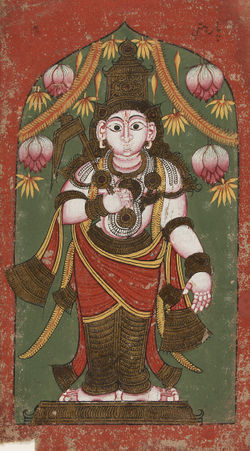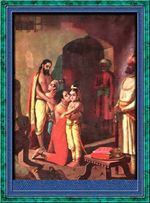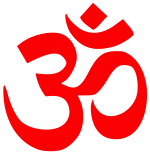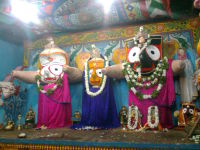Balarama
| Balarama | |
|---|---|
 17th century mural of Balarama from a wall hanging in an Indian temple. |
|
| Devanagari | बलराम |
| Affiliation | Avatara of Vishnu or Shesha |
| Weapon | plough or mace |
Balarama (बलराम, Balarāma), also known as Baladeva, Balabhadra and Halayudha, is the elder brother of the divine being, Krishna in Hinduism. Within Vaishnavism and a number of South Indian, Hindu traditions Balarama is worshipped as an avatar of Vishnu, and he is also listed as such in the Bhagavata Purana.[1] Within both the Vaishnava traditions and Hinduism generally he is acknowledged as being a manifestation of Shesha, the serpent on whom Vishnu rests.
The Bhagavata Purana describes Krishna as the original Supreme Personality of Godhead from whom everything else emanates. As part of this divine 'emanation', Krishna's very first expansion is Balarama, and from Balarama all other incarnations of God then appear. Of the three transcendental elements described in Sanskrit as sat, cit and ananda (eternity, knowledge and bliss), Balarama is in charge of eternity and knowledge. Hence he is worshipped as the supreme teacher or Adiguru.
Contents |
Life
Various narratives related to Balarama are found in the Mahabharata, the Harivamsha, the Bhagavata Purana and several other Puranas. This summary is based on these narratives.
Birth
Balarama was born as a son of Vasudeva. Kamsa, the brother of Devaki and an evil king, was intent upon killing all the children of his sister because of a prediction that he would die at the hands of her eighth son. Kaṁsa thus threw his sister Devaki and her husband Vasudeva into prison, and proceeded to kill each of their children as they were born. However, the seventh child was transferred miraculously from Devaki's womb to the womb of Rohini, who had desired a child of her own. Thus Balarama's other name is also Saṃkarṣaṇa which describes the transfer of the child from the womb. The child was formally named Rama, but because of his great strength he was called Balarama (Strong Rama), Baladeva or Balabhadra. Thus, Rohini actually gave birth to Balarama and raised him.He was born under Shravana nakshatra in Shraavana purnima or Raksha bandhan
Childhood and marriage
,_ca_1585-1590.jpg)
One day, Nanda Maharaja requested Gargamuni, the family priest to visit their home in order to give names to Krishna and Balarama. When Gargamuni arrived at his house Nanda Maharaja, received him very well and then requested him to perform the naming ceremony. Gargamuni then reminded Nanda Maharaja that Kaṁsa was looking for the son of Devaki and said that if he performed the ceremony very opulently it would come to the notice of Kamsa, who would then suspect that Krishna was the son of Devaki. Nanda Maharaja therefore asked Gargamuni to perform the ceremony in secret, and Gargamuni did so giving the reasons for Balarama's names as follows:
"Because Balarama, the son of Rohini, increases the transcendental bliss of others, His name is Rama, and because of His extraordinary strength, He is called Baladeva. He attracts the Yadus to follow His instructions, and therefore His name is Sankarshana." Bhagavata Purana 10.8.12
Balarama spent his childhood as a cowherd boy with his brother Krishna and friends. He killed Dhenukasura, an asura sent by King Kamsa and later Mushtika, a wrestler of Kamsa before Kamsa's death. After Kaṁsa's death, he and Krishna went to the sage Sandipani's ashrama at Ujjayini for study. He later married Revati, the daughter of King Kakudmi, ruler of Kuśasthalī or Anarta[2]
In the Kurukṣetra war of the Mahābhārata

Balarama famously taught both Duryodhana of the Kauravas and Bhima of the Pandavas the art of fighting with a mace. When war broke between the Kauravas and the Pandavas, Balarama was equally affectionate to both parties and so decided to be neutral. Eventually when Bhima (of greater strength) defeated Duryodhana (of greater skill) by dealing a blow below the navel with his mace (a move against the rules of mace combat), Balarama threatened to kill Bhima. This was only prevented when Krishna reminded Balarama of Bhima's vow to kill Duryodhana by crushing the very thigh he exposed to his wife Draupadi.
Death
In the Bhagavata Purana it is described that after Balarama took part in the battle that caused the destruction of the rest of the Yadu dynasty, and after he witnessed the disappearance of Krishna, he then sat down in a meditative state and departed from this world.[3] In some accounts it is described that a great white snake left Balarama's mouth at this point in reference to his identity as Ananta-Sesha. And the place where he departed from this world is situated about 1 km far from Somnath Temple in Gujarat. There is one cave at that place and the white snake who came out of Balarama's mouth got into that cave and went back to Paatal Lok as the local people of Veraval says.
Balarama worship

One of the early references of Balarama worship is found in Kautilya's Arthashastra (13.3)[4] Early individual Balarama worship was followed by his worship along with Krishna by various Vaishnava sects.
Pancharatra belief
The Pancharatras, one of the earliest Vaishnava sects worshipped Samkarshana as the second vyuha of Godhead.

Gaudiya Vaishnavas believe that Balarama is the Supreme Personality of Godhead himself. He is worshipped as equal in supremacy to Krishna, yet wherever Krishna appears, Baladeva appears as Krishna's brother, sometimes elder, sometimes younger. Balarama is constantly serving Krishna in every respect in all of Krishna's incarnations and manifestations. In Rama-lila, Balarama serves Ramachandra as his younger Brother, Lakshmana and in the current age (Kali-yuga), Balarama spreads the 'Sankirtan movement' of Chaitanya Mahaprabhu as his close friend Nityananda.
The only theological difference between Krishna and Balarama is that the bodily hue of Krishna is dark and that of Balarama is fair. Krishna is the Creator, and Balarama is his creative potency, but they are both worshipped as the Supreme Primeval Lord.
Iconography

Balarama is almost always depicted as being fair skinned, especially in comparison to his brother, Krishna, who is shown as dark blue or black. His āyudhas (weapons) are the hala (plough) and the gadā (mace). Traditionally Balarama wears blue garments and a garland of forest flowers. His hair is tied in a topknot and he has earrings, bracelets and armlets. Balarama is described as being physically very strong.
In Jainism
Jain puranas, (notably, the Triṣaṣṭiśalākāpuruṣacarita of Acharya Hemachandra) narrate hagiographical accounts of nine Baladevas or Balabhadras, who are believed as the śalākāpuruṣas (literally, torch-bearers, great personalities). These nine Baladevas are: Achala, Vijaya, Bhadra, Suprabha, Sudarśana, Ānanda, Nandana, Padma (Rama in Hinduism) and Rāma (Balarama in Hinduism).[5]
Quotations
- "Lord Balarama is the original Vishnu; therefore anyone remembering these pastimes of Lord Balarama in the morning and the evening will certainly become a great devotee of the Supreme Personality of Godhead, and thus his life will become successful in all respects." - A.C. Bhaktivedanta Swami Prabhupada
- "The splendor of Lord Balarama's transcendental form eclipses many millions of glistening rising moons, and the slightest scent of His boundless strength is sufficient to destroy many armies of demons." - From Appreciating Sri Vrindavana Dhama, pg. 111
Gallery
 Balarama, holding mace and conch on a Maurya coin (lower right), 3rd-2nd century CE. British Museum. |
,_ca_1585-1590.jpg) Balarama Kills Dhenukasura |
See also
- Lakshmana
- Nityananda
- Shesha
- Vishnu
- Subhadra
- Jagannatha
References
- ↑ Bhag-P 1.3.23 "In the nineteenth and twentieth incarnations, the Lord advented Himself as Lord Balarama and Lord Krishna"
- ↑ Pargiter, F.E. (1922, reprint 1972). Ancient Indian Historical Tradition, New Delhi: Motilal Banarsidass, p.98
- ↑ Bhag-P 11.30.26
- ↑ Rangarajan, L.N. (1992) (edited, rearranged and translated), Kautilya - The Arthashastra, New Delhi: Penguin, ISBN 0-14-044603-6, p.518
- ↑ Joshi, N.P. (1979) Iconography of Balarama, New Delhi: Abhinav Publications, ISBN 8170171075, p.5
External links
- Who is Lord Balarama (Overview)
- 1000 names of Lord Balarama
- Vedic Encyclopedia - Sri Balarama's Pilgrimage
- Balarama avatar - Bhagavata Purana
- Krishna-Balarama Temple
- Krishna & Balarama Deity Gallery - Vrindavan.com
- Krishna & Balarama Deity Gallery - Vrindavan-dham.com
|
||||||||||||||
|
|||||||||||
|
|||||||||||||||||
|
||||||||||||||||||||||||


